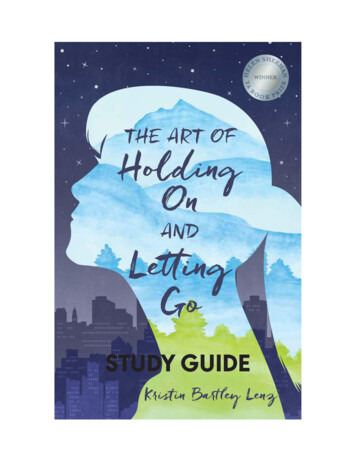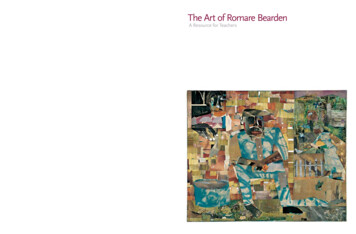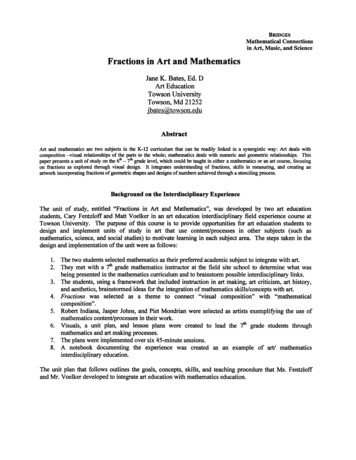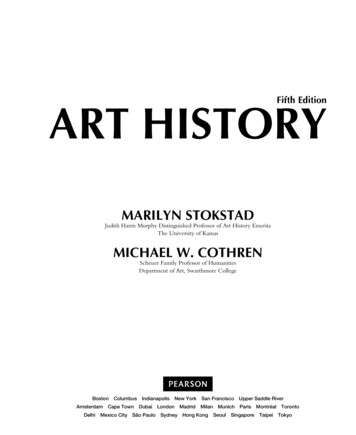
Transcription
The Art of Holding On and Letting Go Study Guide-2Thanks for reading and studying the novel. The below prompts, questions, and activities can beused in any order, and we encourage instructors to adapt and make them their own.Study Guide TOC Activity: Time to Write: Out of Your Comfort ZoneActivity: Judging a Book by Its CoverActivity: Character WebsActivity: Comparing the DraftsDiscuss: The Tale of Two DraftsActivity: ResearchDiscuss: Cara and the Piano PlayerActivity: Exploring a Book Through Its CoverActivity: Time to Write: You Are Who You MeetActivity: Group Breakout DiscussionActivity: Time to Write: Where You Are Is Who You AreElephant Rock Books
The Art of Holding On and Letting Go Study Guide-3TIME TO WRITE: OUT OF YOUR COMFORT ZONEThink of a time you were new to a place or met a person for the first time, when being new tothat place or meeting that person made you feel like an outsider. This could have been a bigmove to a different town, your first day at a new school, the first time you visited a friend’shouse and met his or her family, or any situation where your surroundings were different thananything you’d experienced before in a way that was uncomfortable for you. Free write for fiveminutes about that experience. How did the place look, sound, or smell? What was the personlike? At first glance, did they seem warm, welcoming? Did they seem distant and cold? Whatwere you feeling and thinking? What was unfamiliar and what was familiar? Try to writeyourself back into that moment by using the first person and, if you so choose, the present tense.ACTIVITY: JUDGING A BOOK BY ITS COVERBefore you begin reading, examine the cover of The Art of Holding On and Letting Go. Keep inmind that cover decisions are deliberate. They are the product of collaboration between adesigner, publisher, and author. From viewing the front cover, what do you assume the tone ofthe book will be? Where do you think the story takes place? Can you assume anything else aboutthe book from the cover? Read the description on the back of the book. What are you curious toread more about? What conflicts do you think the book will address? Jot your thoughts down in ajournal so you can revisit them when you finish reading The Art of Holding On and Letting Go.ACTIVITY: CHARACTER WEBSAfter reading the first chapter of the novel, create a character web like the one below for Cara.Fill in the bubbles with as much detail as possible about her life, her motivations, her likes anddislikes, her relationships with other characters (especially her parents), etc. Cite page numbersand specific passages to support your conclusions. Add to this web as you continue to read thenovel. Make and add to webs for other major characters as they are introduced.Elephant Rock Books
The Art of Holding On and Letting Go Study Guide-4ACTIVITY: COMPARING THE DRAFTSCompare and contrast the following drafts of the first chapter of The Art of Holding On andLetting Go. We have provided the draft Lenz first submitted for publication as well as the finaldraft. As you read, pay attention to setting, pacing, characterization, and point of view. Highlightareas where the author made changes.SUBMITTED DRAFTCHAPTER 1It was the second day of qualifying rounds, and I was up next.Becky stood next to me. She had climbed earlier, but fell off a hold a few feet from thetop.“You’re lucky your parents aren’t here. Mine are making me way nervous.” Becky’sslight southern drawl stretched out the word, “Miiine.”I sipped lukewarm peppermint tea from my thermos and followed her gaze to her parentsin the bleachers. They waved, but Becky turned away. I gave them a thumbs-up.“Just don’t look at them before your next climb,” I said.My parents never made me nervous, but there was something freeing about being here bymyself, as a serious competitor, and not as the daughter of top mountaineers Mark and LoriJenkins.“At least your parents have a life,” Becky said. “My mom would never leave me alone ina foreign country.”Mom hadn’t been comfortable leaving me either. We’d debated our plan for weeks, but inthe end, I had insisted. Mom should go on the Chimborazo expedition with Dad and Uncle Max.I shrugged. “They’ll be back by the finals.”“What if we don’t make it to finals?”I arched an eyebrow at her. I would make it to finals.Elephant Rock Books
The Art of Holding On and Letting Go Study Guide-5“Cara Jenkins,” the announcer called, “age fifteen, from California, the United States ofAmerica, los Estados Unidas.”I handed Becky my thermos of tea and stepped away from her, shaking off ourconversation. I took a deep breath, twinkled my fingers, and scanned the route. Sixty vertical feetof soaring artificial walls with exposed overhangs. The crowd was hushed on the bleachersbehind me. I tied the rope to my harness and dipped my hands in my chalk bag. A puff of whitedust floated in the air as I rubbed my palms together.I reached for the first handhold and let everything else fade behind me. Steady breath,reach, grasp, pull, push, pivot, twist. My fingers around a doorknob bulge, pinched anothershaped like a duck’s bill. The sandpapery surface scraped my calloused fingertips. My forearmsquivered. My bruised toes jammed at the front of my climbing shoes, supporting my weight.One handhold left, a tiny crimper. I balanced on the tip of my big toe, stretched, andinched myself up with the last bit of strength in my muscles. My balance teetered. I locked myeyes on the grooved nugget above my head. Breathe. My hand trembled as I reached upward.Come on, Cara, almost there. A final surge of energy erupted from my core, and I grasped thehold with two iron-claw fingers. Yes! I clipped the bolt, threw my head back and grinned at thesky.I paused to take in the view and catch my breath. My heart pounded all the way up to myears. Over the top of the climbing wall, I searched the hazy distance for the snow-capped peaksof the Cordillera Occidental, the Avenue of Volcanoes. Yesterday, the mountains were clearlyvisible, grand domes and jagged peaks against a backdrop of blue sky. But this morning, theAndes wore a mask of clouds. My parents were out there with Uncle Max, high on Mt.Chimborazo.Elephant Rock Books
The Art of Holding On and Letting Go Study Guide-6The breeze swept across my face, ruffling my bangs and cooling the sweat on myforehead. I closed my eyes and sent a wish to my family, imagining my words traveling with thewind. They’d left four days ago. If all went as planned, they had reached the summit near dawnand were descending at this very moment.My feet back on the ground, I untied from the rope with shaky hands. Heat pulsedthrough my body, from my blood to my muscles to my skin. I sneaked a sideways glance at thecrowd of clapping spectators.The crowd had disappeared from my mind while I climbed, and I never knew quite howto act when I finished a route. Usually, my gaze would connect with my parents. Mom’s facewould look relieved, and Dad would send signals with his expression, a nod or shake of his head,analyzing my performance.They would be here in two days, in time to see me compete for my world ranking. Ispotted my coach and teammates, and grinned and waved.Elephant Rock Books
The Art of Holding On and Letting Go Study Guide-7PUBLISHED DRAFTCHAPTER 1The waiting was the worst. I gripped my worry stone from Uncle Max, turning it aroundand around in my hands. My fingers probed its golden grooves and contours. The sharp edgesshimmered.My teammate Becky sat next to me in the isolation tent examining her red, white, andblue–painted nails. It was the second day of qualifying rounds, and we’d been waiting two hoursfor our turns to climb. Tiny stars dotted her thumbs. I didn’t understand why she bothered—thepolish always chipped by the time she finished her climb.My own nails were cut as short as possible, my fingers rough and calloused. A crosshatchof red lines spread across the back of my right hand where I had wedged it into a crack last week,the rock scraping my skin. I couldn’t tell yet if it would leave a scar like the other white markson my hands, the crooked gash on my thumb, my pitted palm.“Ugh,” Becky said. “I want my phone. Seriously, I’m, like, twitching. Look.” Shepointed to her eye.“Maybe you got mascara in it.” Her lashes were so clumped and coated, they looked fake.She’d scrolled through her phone at breakfast, tilting it toward me so I could see thepicture of her hand placed over her heart like she was reciting the Pledge of Allegiance. She’dmanaged to display our USA team logo, her cleavage, and her patriotic nails all in one close-upshot. Four hundred likes.No phones allowed in the tent, and no checking out the routes before we climbed; thecanvas walls blocked our view of the competition area. A collective groan came from thebleachers outside. Someone had fallen.Elephant Rock Books
The Art of Holding On and Letting Go Study Guide-8“Another one bites the dust.” I tumbled the stone faster and faster in my hands. I swear Icould feel its heat, its fire.“It’s pyrite. Fool’s gold,” Uncle Max had said. “Named after fire. It’ll spark if you strikeit against steel, so they say. Want to try?”For the rest of the day, we struck it against anything metal we came across—tent poles,car rims—startling ourselves and giggling every time we saw the tiniest spark.Becky nudged me with her elbow and nodded toward our teammate Zach. “SleepingBeauty.”Zach was sprawled on his back, shirtless, his blue-and-white team tank top wadded underhis head as a pillow. His eyes were closed, ear buds in. Zach always spent his isolation timelistening to music on his iPod and snoozing.“He climbs right before you,” I said to Becky. “Make sure he’s up after I leave.”“Oh, I will.” Her slight southern drawl stretched out the word will, her lips curving into asly grin.I knew exactly how she’d wake him up, leaning in close so he’d open his eyes to herboobs in front of his face. I didn’t understand how Becky could be so strong yet look so soft andcurvy at the same time. I was all bone and muscle. My own chest looked like Zack’s—twonipples sticking out of rippling, hard pecs.A burst of laughter erupted from the other side of the tent. The French team lounged in aclump, girls and guys draped all over each other. They held hands, rested heads in laps,massaged each other’s feet.Elephant Rock Books
The Art of Holding On and Letting Go Study Guide-9Becky had been eyeing them all morning. She rolled her eyes and laughed with me, but Iknew she’d rather be hanging with them. In their cozy company, she’d have an excuse to hangall over Zach.Becky sighed. “You’re lucky your parents aren’t here. Mine will be whistling and wavingas soon as my name is announced. They make me so freaking nervous.”I glanced at the large digital clock over the tent’s door. My name would be called soon. Iset the chunk of pyrite next to my backpack and picked up my thermos of peppermint tea.“Just don’t look at them before you climb,” I said.“I can’t help it. I always want to see who’s in the crowd.”I sipped my lukewarm tea. The crowd made me nervous, not my parents. Knowing theywere in the audience usually calmed me, but there was something freeing about being here bymyself this time, as a serious competitor, not as the daughter of top mountaineers Mark and LoriJenkins.“At least your parents have a life,” Becky said. “My mom would never leave me alone ina foreign country.”Mom hadn’t been comfortable leaving me. We’d debated our plan for weeks, but in theend, I had insisted. Mom should go on the Chimborazo expedition with Dad and Uncle Max.I shrugged. “They’ll be back by the finals.”“What if you don’t make it to finals?”I arched an eyebrow at her. I would make it to finals.A competition volunteer appeared at the tent entrance and motioned for me to follow. Ihanded Becky my thermos of tea and tugged on my well-worn, broken-in shoes. As long as theElephant Rock Books
The Art of Holding On and Letting Go Study Guide-10rubber soles were still grippy, I wasn’t giving them up. Becky was still trying to decide which ofthe three shiny new pairs she’d brought looked best with her outfit.I shook out my hands and cracked my knuckles. I rose up on my tiptoes and bounced. Up,down, up, down.I nudged Zack’s ribs with my toe on my way out, and he opened one eye.“Send it!” he called out as I left the tent. I gave a thumbs-up without looking back andentered the competition area.I squinted in the bright sunlight and slowly let my eyes adjust. The bleachers were a seaof color: parents and fans and climbers. The World Youth Championships banners covered thefencing that enclosed the outdoor venue. A gust of wind rippled the flags of all the countries.Russia, Australia, China, Mexico, Canada.“Cara Jenkins,” the announcer boomed, “age fifteen, from California, the United States ofAmerica, los Estados Unidos.”The crowd buzzed, a nest of bees, murmuring and shifting; I didn’t look. Someonehooted. Another whistled. I took a deep breath, twinkled my fingers, and scanned the route. Sixtyvertical feet of soaring artificial walls with exposed overhangs. I tied the rope to my harness anddipped my hands in my chalk bag. A puff of white dust floated in the air as I rubbed my palmstogether.I nodded at the belayer. “Climbing.”“Climb on,” he said with a Spanish accent. His face was neutral, all business, and mademe long for a brief look of reassurance from my parents.I reached for the first handhold and let everything else fade behind me. Steady breath,reach, grasp, pull, push, pivot, twist. My fingers wrapped around a doorknob bulge, pinchedElephant Rock Books
The Art of Holding On and Letting Go Study Guide-11another shaped like a duck’s bill. I slid my hands along a large diamond-shaped protrusion. Thesandpapery surface scraped my calloused fingertips. My forearms quivered. My bruised toesjammed at the front of my climbing shoes, supporting my weight.One handhold left, a tiny crimper. I balanced on the tip of my big toe, stretched, andinched myself up with the last bit of strength in my muscles. I teetered. I locked my eyes on thegrooved nugget above my head. Breathe. My hand trembled as I reached upward, the nugget likethe pyrite I had tumbled in my hands earlier. Come on, Cara, you know how to do this.A final surge of energy erupted from my core, and I grasped the hold with two iron-clawfingers. Yes! I clipped the bolt, threw my head back, and grinned at the sky. My heart poundedall the way up to my ears. Over the top of the climbing wall, I searched the hazy distance for thesnowcapped peaks of the Cordillera Occidental, the Avenue of Volcanoes. Yesterday, themountains had been clearly visible, grand domes and jagged peaks against a backdrop of bluesky. But this morning, the Andes wore a mask of clouds. My parents were out there with UncleMax, high on Mount Chimborazo.The breeze swept across my face, ruffling my bangs and cooling the sweat on myforehead. I closed my eyes and sent a wish to my family, imagining my words traveling with thewind. They’d left four days ago. If all went as planned, they had reached the summit near dawnand were descending at this very moment.The belayer lowered me back to the ground, and I untied from the rope with shaky hands.Heat pulsed through my body, from my blood to my muscles to my skin. I sneaked a sidewaysglance at the crowd of clapping, cheering spectators.I never knew quite how to act when I finished a route. Usually, my gaze would connectwith my parents. Mom’s face would look relieved, and Dad would send signals with hisElephant Rock Books
The Art of Holding On and Letting Go Study Guide-12expression, a nod or shake of his head, analyzing my performance. Uncle Max would cross hiseyes or make some sort of goofy face, making me smile, releasing the tension. I’d really needthem in two days, when I competed for my world ranking.I spotted Coach Mel and my teammates who had climbed earlier. I grinned and waved,and left the stage to join them.Elephant Rock Books
The Art of Holding On and Letting Go Study Guide-13DISCUSS: THE TALE OF TWO DRAFTS1. Note areas where Lenz added details about Cara’s past. How does this affect the pacingof the chapter?2. Notice that the first line of the published draft is very different from the first line of theoriginal draft. What has changed between these two drafts of the opening line? How doesthe first line of the final draft bring the reader more immediately into the events of thestory?3. What changes do you notice in the characterization of Becky in the original draft versusthe final draft? Consider, for example, the addition of the character of Zach.4. Notice how the climbing scene is largely unchanged from the original draft to the finaldraft. Why do you think this scene was left as it was? Compare the climbing scene in theoriginal draft to the rest of the first chapter in the original draft. How does the climbingscene compare in terms of the level of detail and the strength of Cara’s voice?5. How has the pacing of the chapter changed from the original draft to the final draft? Whateffect has slowing the pace down for the final draft had on the flow of the novel and thedepth of its characters? Which draft feels more intimate? Why?6. How might you apply similar revision techniques to better communicate something inyour own writing, whether it’s an essay or fiction piece?Elephant Rock Books
The Art of Holding On and Letting Go Study Guide-14ACTIVITY: RESEARCHFind one or two outside resources on mountain climbing (on famous mountains to climb, famousclimbers, training to climb, climbing competitions, etc.). Think about how Cara’s parents beingfamous mountain climbers has made her different from her friends from Detroit. On page 96, shesays, “I hadn’t shared anything about my family so far. For all practical purposes, they’dabandoned me.” Looking at your outside resources, what does being a professional climber seemto involve? Has that lifestyle perhaps led to Cara’s parents “abandoning” her? Or is it possible,being a climber, to be as attentive as any other busy parent?DISCUSS: CARA AND THE PIANO PLAYERThroughout the novel, Cara pulls from the nature writings of John Muir, Henry David Thoreau,and Annie Dillard. She also refers back to Kurt Vonnegut’s line from Piano Player:I want to stand as close to the edge as I can without going over. Out on the edge you seeall the kinds of things you can’t see from the center.This saying appears four times: as the epigraph for part I, on a postcard Cara’s dad sends her(page 24), in Cara’s conversation with Coach Mel during the hunt for her parents (page 33), andduring Cara’s final climbing trip with her friends (on page 291). Why is this quote used as theepigraph for part I? What has changed for Cara by the end of the book, and why is this the quoteshe goes back to on page 291? How does it mean something different at the end of the book fromwhat it meant at the beginning? What might this changed meaning signify in terms of Cara’srelationships with her parents?ACTIVITY: EXPLORING A BOOK THROUGH ITS COVERThink back to the pre-reading exercise you did where you looked at the front and back covers ofThe Art of Holding On and Letting Go and predicted things like setting, tone, and conflicts.Again, remember that covers are products of collaboration between a designer, publisher, andauthor. Keeping that in mind, now that you’ve actually read about the setting, tone, and conflictsof the story, how would you design the cover of this novel? Write about or even draw your planfor a cover. Why did you choose the design you chose? Have textual evidence at hand to supportyour design decisions.TIME TO WRITE: YOU ARE WHO YOU MEETThink back to the character web activity you did before you read the book. Beyond mappingCara’s character over the course of the story, which other characters did you map out? Chooseone of those other characters, perhaps Kaitlyn or Nick, and think about how meeting thatcharacter changed Cara from the person she was at the beginning of the book to the person she isat the end. Then, write a short essay about a person in your own life who had as significant animpact on you as Cara’s friends have on her. Why did you choose the relationship you chose towrite about? Why does it remind you of Cara’s story? Use textual evidence to support yourreasoning.Elephant Rock Books
The Art of Holding On and Letting Go Study Guide-15ACTIVITY: GROUP BREAKOUT DISCUSSIONReview the “Questions and Topics for Discussion” below or in the back of the book. Assign twoquestions or topics to small groups to discuss amongst themselves. Reconvene and have eachgroup present their thoughts to the class.Questions and Topics for Discussion1) How do the writings of naturalists such as John Muir, Henry David Thoreau, and AnnieDillard shape Cara’s worldview?2) Cara is deeply affected by the death of her uncle Max. In what ways does she mourn andcelebrate his memory?3) The contrast between Cara’s climbing life and her suburban life are in conflict throughout thenovel. How does she make peace with these competing landscapes?4) Cara feels most free when she’s climbing. What activity in your life brings you this kind ofjoy and liberation?5) Did you notice the lack of technology in Cara’s life? What are the effects of Cara not havingher nose buried in a cell phone 24-7? What is she able to experience more fully?6) How does being an outsider on the climbing team and in school shape Cara’s identity?7) How does Kaitlyn’s experience and growth throughout the novel mirror Cara’s? How do thesefriends help each other?8) How does Cara’s relationship with her free-spirited parents evolve over the course of thenovel? What does Cara understand about her parents at the end of the book that she didn’t at thebeginning?9) Compare and contrast the three different settings of the novel. How do these environmentscontribute to the action and meaning of the book?10) Cara spends the first two-thirds of the novel wanting to return to California. What does sherealize about the meaning of home during her time with Nick, Kaitlyn, and her grandparents?Elephant Rock Books
The Art of Holding On and Letting Go Study Guide-16TIME TO WRITE: WHERE YOU ARE IS WHO YOU ARESetting is a big part of this novel, especially in terms of how it shapes Cara’s identity. Think backto a time when you read a fiction or non-fiction piece in which the author used setting as a wayto either understand or explain themselves or their main character to the reader. Then, becreative, and write a short fiction or non-fiction piece in which the main character (who may beyou) is shaped by his or her setting.Elephant Rock Books
The Art of Holding On and Letting Go Study Guide-5 Elephant Rock Books “Cara Jenkins,” the announcer called, “age fifteen, from California, the United States of America, los Estados Unidas.” I handed Becky my thermos of tea and stepped away from her, shaking off our conversation.










